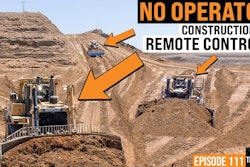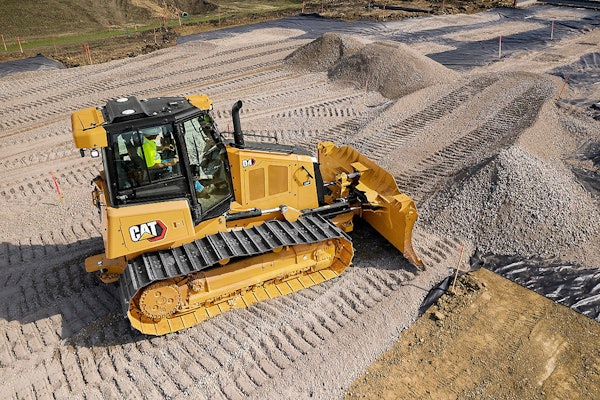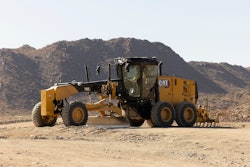If you’re looking for a quicker, simpler way to buy parts for your equipment, you’ll want to check out this episode of The Dirt.
Luke Powers, founder and CEO of Gearflow, talks about the digital marketplace his company has created to connect equipment owners with parts suppliers in one online platform.
Gearflow focuses on three main goals:
- Easier access to parts.
- Better communication between buyers and sellers.
- Increased visibility of machine performance and historical data.
Not only will Gearflow help you locate the parts you need, but it can also hook you up with a delivery driver to further reduce downtime.
To learn more about Gearflow and how it can help contractors, watch this week’s episode of The Dirt.
Equipment World serves up weekly videos on the latest in construction equipment, work trucks and pickup trucks – everything contractors need to get their work done. Subscribe and visit us at equipmentworld.com!
In This Episode:
00:00 - Simplifying Parts Procurement With Gearflow
00:27 - What Are the Biggest Issues With Parts Procurement Today?
03:04 - How Does Gearflow Work?
05:07 - How Can Multiple People Within a Company Use Gearflow?
08:09 - Can You Order Through 3rd Party Vendors and Dealerships?
09:06 - Data Insights Using Gearflow
10:15 - How Can I Start Using Gearflow?
10:50 - Why Technology That Can Reduce Downtime Is So Important
11:40 - Final Thoughts
Bryan Furnace (00:00):
Today we're going to talk about an exciting topic of parts procurement, because instead of sitting in your truck, calling a bunch of places to try to find the part for your machine that's down, instead you can head over to Gearflow and you can do this digitally. So without further ado, we're going to talk with Luke Powers from Gearflow.
(00:27):
What is Gearflow and how exactly does it work? How does it simplify that parts procuring process?
Luke Powers (00:32):
We've had conversations with hundreds of fleet teams, so think heavy civil contractors. They're running multiple brands, they're in multiple states. It's hard for them to stay on top of their parts procurement on a per machine basis, as well as guys that just have a few machines too. Its just, there's a lot of pains associated with it that roll up into downtime. Equipment is the largest capital expense on the job, but it's really that downtime is the hidden cost which really eats into our margin on the job sites, which is 5.5% ish as you know, Bryan.
(00:59):
But really what that breaks down to the three biggest pains we've heard from fleet teams is, "Hey, number one, I would love easier access to the parts we need when we need them. And we'd love to be able to have an easier way to work with our dealers, where we are and the places we work. Number two, we want better communication. Now communication is in phone calls and texts and emails, it's kind of all over the place. It's hard for me to stay on top of what I'm requesting from whom and when. And the third is visibility. I don't have a good way as a fleet manager to catch cost anomalies in real time."
(01:29):
The parts transaction should tell me so much about my fleet that I should know in real time, and not 60 to 90 days later when I got to dig it out of QuickBooks or whatever. How is that operator performing? How is that machine performing in the field? How can we get out in front of repairs? Maybe when is it a good time for me to sell an asset? Am I spending too much on an asset that, again, I don't know about in real time?
(01:48):
These are all things that we're so heads-down because we're getting paid to do the job we do, excavation or whatever equipment serves us, serves the job. But the whole process of keeping that equipment running, certainly when it comes to parts, should be a lot easier. In where we are today software is all around us. Software should serve us to be a better contractor, and it should serve our dealers to help them get us the parts we need when we need them. And that's what we're about at Gearflow. We focus on those three things, access, communication and visibility, and having a lot of fun doing it.
Bryan Furnace (02:22):
Okay. You tell me if we can improve upon my system, because my system is, when I have my machine go down, I go out there, I throw the wrenches, pull the part off. Then I have to go to my pickup truck and I have to call my local dealership and I have to get the part number. And that's where I use this trusted notebook that I got here so I can write down my part numbers and my prices.
(02:43):
But then it's always good to be diligent, and so I'm going to call a couple other vendors so that I can also write down their prices. And then once I get my prices, I have to order the part and figure out where I got to go pick it up, and then I'm finally ready to repair my machine. But you're telling me that this is an easier way?
Luke Powers (03:03):
If you can believe it. Yeah. Yeah, right. So through Gearflow you get on, you select that machine it's for. And let's say you blew a hydraulic hose, and you want to understand where can I get the hydraulic hose locally right away because my machine's down and my job might be stopped. Through the platform you can send that to a local dealer. You can also send it to others in your area, maybe it's a local hydraulic shop or whomever. And that takes just a few seconds of submitting that parts request out.
(03:30):
So you do those couple of seconds, you get right back to work. Maybe you pull that hose out, maybe you're doing something else on the job. But the point is, you're getting responses back in minutes and so you can get back to work. You get responses back from whom you trust. And you can either of course go pick up the parts like you do today, or you could dispatch a driver actually through Gearflow to go pick them up. So they're like Uber for job sites, but you can dispatch a car, truck SUV to go pick up that hose.
Bryan Furnace (03:56):
Now just out of curiosity, on the dispatching side, is that a pretty available service? Because rural, out in the sticks, are you going to have a hard time locating a driver typically, or have you found that the coverage is pretty decent on that?
Luke Powers (04:09):
Yeah, we've partnered with a company that's all they do. The company's called Curri and all they do is job site deliveries. And so it's in the lower 48 states, for anybody else listening outside of that, but that's the coverage area. And yeah, it's out to the sticks all the time. And again, it's car, truck, SUV. It's up to you, what you want to send really depends on how big that part is. But it's the same thing. You get the visibility, "Where's my driver?" That driver's going to have the PO number, so go pick it up and we'll call from that dealer. The dealer's going to see where the driver is, so it's all visible.
(04:37):
And the whole point of that is, it goes back to that access point, so access, communication, and visibility. That is just such an easier way for certainly you to stay on the job, and you not to drive an hour and a half round trip or two hours round trip. Or a mechanic that you're paying fully loaded easily over $100 an hour, that's costing more and more. Can you just get when you want, on-demand pickups, so that you can stay productive on the job. It's all about that. How do we get the parts we need when we need them from whom we trust, so we can keep doing our work.
Bryan Furnace (05:07):
For owner operators, smaller guys like myself, not a big deal. I go on, I order all my own parts, there's not a bunch of moving pieces. Are you guys structured in a way that maybe for some larger companies that have a fleet manager, but you also have your field mechanic or you may have someone else or a foreman or superintendent that may need to be kept in the loop, are you guys geared in a way that you can have multiple people in this process together or at least staying abreast of the situation?
Luke Powers (06:53):
Yeah, so for your situation, you're wearing all the hats. And as the fleet grows, as your business grows, you're going to hire people to wear those hats. That's great. And so larger contractors who have fleet teams, they'll have maybe a couple of people in the office, then they'll have field operations, and so they'll have maybe their own approval process. So how does that parts request originate from the operator to maybe the foreman, back to the office?
(07:13):
There's different nuances of whom is ordering that part or requesting those parts, but that can all be done within the platform. You can set approval thresholds and that internal communication can run through the platform, of course as well as external communication to your dealers. But that internal approval process can just be a lot simpler and a lot more automated so that again, those operators in the field team stay working, the guys in the office or the shop get what they need when they need it. And they're adding as many users as they'd like. Maybe accounting would like to see this. Maybe accounting would like to see what invoices are coming in from such and such vendors and staying on top of all of our parts purchasing in one place. Certainly management wants to see that visibility.
(07:51):
Yeah, Bryan, you're exactly right. The bigger the organization, that's great, and it doesn't really matter what size, you can add as many users as you need. And try to simplify the workflows internally as well as of course externally, so everybody drives more productivity and more margin to the job.
Bryan Furnace (08:09):
And just to verify, I don't have to only order through dealership and I don't only have to order through third-party vendors, you guys have the ability to mesh those two so that I'm able to compare back and forth between the two?
Luke Powers (08:19):
You got it. So yeah, in one workflow it goes out to your dealer. In another workflow, it goes out to a network, where you get options back that are high-quality aftermarket parts, genuine parts, as well as other dealers.
(08:29):
But the whole point is, it takes you just a few seconds to send that request out with that machine number. By the way, the most important data point on that machine is that serial number. And so that's going to send out to make sure you get the right parts that fit that machine, so you're back to work and you'll get multiple options back. It's one place for you to then ask questions, they're asking questions of you. Maybe they need a picture of the engine, if it's an engine part or whatever. But that's all done, it's all logged in one place so you're not poking around on Google for hours.
Bryan Furnace (08:58):
Bouncing between 15 different websites or 15 different email chains or yeah, that's all one-spot. That's convenient. I think you alluded to it a little bit earlier, but you actually have the ability to go back and look at your historical data on all of your machines. Is that correct?
Luke Powers (09:15):
Yeah. On a per machine basis, you're going to collect all the history against those orders and requests. You're also going to capture all the photos you've uploaded against that asset. You're also going to see where it is, if there's a telematics integration. So you're going to get really rich data on a per asset basis. And then you're also going to get more macro data, by timeframe, by vendor you've ordered from, by whom on your team, to start to catch trend lines that we were talking about earlier. That's all out of the box and very easy to drill down to your orders.
(09:43):
And I would say, I think, Bryan, a big learning we've had is task management. The main thing is the main thing, is finishing the job on time or early.
Bryan Furnace (09:51):
Sure.
Luke Powers (09:51):
Keep that the main thing. When it comes to my parts and keeping my equipment running, it's like, "Okay, wait, where did I leave it off with this machine? Did we place that hydraulic cylinder on order? Was it ..." So we just try to keep the main dashboard simple for task management. This is all based off upon feedback from what we've been told. So you're getting those nice reports you asked about, while also keeping it really simple with, "What do I need to do right now."
Bryan Furnace (10:15):
If I want to go check this thing out, is this a subscription service that I'm going to have to pay before I can even explore the platform? Or is it something that I can get into, kind of poke around and get a feel for it before I'm really committing down a path?
Luke Powers (10:26):
First user is free. So the trialability, there's no risk. You go to gearflow.com, you sign up for an account, and start putting in some parts RFQs and just start trying it out. There's really no risk. And as you add more people on your team, it's $75 per person after that so very manageable cost to the contractor. And yeah, I encourage of course you and anybody else to check it out and let me know what you think.
Bryan Furnace (10:50):
Awesome. Well, Luke, thank you so much. This is interesting and I love seeing technology start to move in some of these other areas. We think of the big ones in the industry like GPS and autonomous machines, but really there's a lot of other aspects of the industry that are being impacted a lot heavier by technology. And this is one of them, downtime is such a huge thing. And the difference of two hours versus 45 minutes of downtime, in a lot of jobs, that's a substantial change to your margin and your bottom line. So this is exciting stuff.
Luke Powers (11:22):
And as you know that what we need to build in the coming decades, so increase our output with the less skilled labor coming into the workforce, we need an orchestra of technology really around the job. And it's going to be different applications and robotics and hardware and software. We think we play in an important role in what we do here for helping simplify parts procurement, but it's a exciting time.
Bryan Furnace (11:41):
Well, thanks again for being on and thanks for all the information.
(11:43):
Well, thanks again to Luke for coming on the show and talking a bit about what Gearflow is doing to help us in the field do our jobs better. And that's why technology like Gearflow is really helping bring the industry up in areas that we've traditionally struggled a little bit. As always, I hope this helps you in your business. Thanks for watching, and we'll catch you guys on the next episode of The Dirt.








